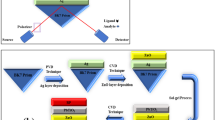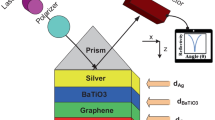Abstract
A highly sensitive surface plasmon resonance biosensor employing BK7 prism, Silver (Ag), zinc oxide (ZnO), ferromagnetic material (Fe2O3), and two-dimensional (2D) nanomaterial black phosphorous (BP) has been proposed. Thin layers of two different oxide layers sandwiched between Ag and BP in Kretschmann configuration. The angular interrogation method–based numerical simulation is applied for modelling of high performance SPR biosensor at a wavelength of 633 nm (visible region). Transfer matrix method and finite element methods have been used to obtain [performance parameters. This sensor can detect malaria at different stages and provides a large range of refractive index (RI) sensing from 1.369 to 1.409. The RI for malaria stages, including the ring, trophozoite, and schizont stages, are 1.396, 1.381, and 1.371 respectively, with corresponding angular sensitivities of 367 deg/RIU, 297 deg/RIU, and 269 deg/RIU. The sensor offers an ultrahigh angular sensitivity for malaria detection in ring stage. This research could pave the way for an important bio sample detection apparatus that allows for quick and precise in ring stage diagnosis.









Similar content being viewed by others
Data Availability
The dataset generated during analysis is available in the present article.
References
Roh S, Chung T, Lee B (2011) Overview of the characteristics of micro- and nano-structured surface plasmon resonance sensors. Sensors 11:1565–1588. https://doi.org/10.3390/S110201565
Wei Wei WW, Jinpeng Nong JN, Linlong Tang LT et al (2018) Reflection-type infrared biosensor based on surface plasmonics in graphene ribbon arrays. Chinese Optics Letters 13(8):082801. https://doi.org/10.3390/S110201565
Srivastava SK, Gupta BD (2011) Influence of ions on the surface plasmon resonance spectrum of a fiber optic refractive index sensor. Sens Actuators B Chem 156:559–562. https://doi.org/10.1016/J.SNB.2011.01.068
Homola J, Yee SS, Gauglitz G (1999) Surface plasmon resonance sensors: review. Sens Actuators B Chem 54:3–15. https://doi.org/10.1016/S0925-4005(98)00321-9
Shakya AK, Singh S (2024) Performance analysis of a developed optical sensing setup based on the Beer-Lambert Law. Plasmonics 19:447–455. https://doi.org/10.1007/s11468-023-01979-7
Shakya AK, Singh S (2023) Development of a generalized Fourier transform model for distinct household oil samples by performing spectroscopy analysis. Results in Optics. https://doi.org/10.1016/j.rio.2023.100355
Butt MA, Kazanskiy NL, Khonina SN (2023) miniaturized design of a 1 × 2 plasmonic demultiplexer based on metal–insulator-metal waveguide for telecommunication wavelengths. Plasmonics 18:635–641. https://doi.org/10.1007/s11468-023-01795-z
Rahad R, Haque MA, Faruque MO et al (2024) A novel plasmonic MIM sensor using integrated 1×2 demultiplexer for individual lab-on-chip detection of human blood group and diabetes level in the visible to near-infrared region. IEEE Sens J. https://doi.org/10.1109/JSEN.2024.3372692
Shakya AK, Ramola A, Singh S, Van V (2022) Design of an ultra-sensitive bimetallic anisotropic PCF SPR biosensor for liquid analytes sensing. Opt Express 30:9233. https://doi.org/10.1364/oe.432263
Shakya AK, Singh S (2023) Novel Merger of spectroscopy and refractive index sensing for modelling hyper sensitive hexa-slotted plasmonic sensor for transformer oil monitoring in near-infrared region. Opt Quantum Electron. https://doi.org/10.1007/s11082-023-05016-z
Shakya AK, Singh S (2023) State of the art alliance of refractive index sensing and spectroscopy techniques for household oils analysis. Plasmonics 18:2347–2364. https://doi.org/10.1007/s11468-023-01940-8
Hoa XD, Kirk AG, Tabrizian M (2007) Towards integrated and sensitive surface plasmon resonance biosensors: a review of recent progress. Biosens Bioelectron 23:151–160. https://doi.org/10.1016/J.BIOS.2007.07.001
Wood RW (1902) XLII. On a remarkable case of uneven distribution of light in a diffraction grating spectrum. The London, Edinburgh, and Dublin Philosophical Magazine and Journal of Science 4:396–402. https://doi.org/10.1080/14786440209462857
Uniyal A, Pal A, Chauhan B (2023) Long-range SPR sensor employing platinum diselenide and cytop nanolayers giving improved performance. Physica B Condens Matter 649:414487. https://doi.org/10.1016/J.PHYSB.2022.414487
Kashyap R, Chakraborty S, Zeng S et al (2019) Enhanced biosensing activity of bimetallic surface plasmon resonance sensor. Photonics 6:108. https://doi.org/10.3390/PHOTONICS6040108
Mishra AC, Sharma AK, Lohia P, Dwivedi DK (2023) Modelling and analysis of high-performing reconfigurable SPR refractive index sensor employing beryllium oxide, nickel, and BlueP/WS2 nanomaterials. Plasmonics. https://doi.org/10.1007/s11468-023-02005-6
El barghouti M, Akjouj A, Mir A (2022) Modeling of surface plasmon resonance biosensor based on Ag/BiFeO3/Ni using 2D nanomaterial perovskite MAPbBr 3. Mater Today Commun 33:104591
Almawgani AHM, Sarkar P, Pal A et al (2023) Titanium disilicide, black phosphorus–based surface plasmon resonance sensor for dengue detection. Plasmonics 18:1223–1232. https://doi.org/10.1007/S11468-023-01856-3/FIGURES/11
Shivangani AMF, Al-Hadeethi Y et al (2022) Numerical study to enhance the sensitivity of a surface plasmon resonance sensor with BlueP, WS2-covered Al2O3-nickel nanofilms. Nanomaterials 12:2205. https://doi.org/10.3390/NANO12132205
Srivastava S, Singh S, Mishra AC et al (2023) Numerical study of titanium dioxide and MXene nanomaterial-based surface plasmon resonance biosensor for virus SARS-CoV-2 detection. Plasmonics. https://doi.org/10.1007/s11468-023-01874-1
Karki B, Uniyal A, Srivastava G, Pal A (2023) Black phosphorous and Cytop nanofilm-based long-range SPR sensor with enhanced quality factor. J Sens. https://doi.org/10.1155/2023/2102915
Singh S, Mishra AC, Singh S et al (2023) Theoretical study of perovskite nano material based surface plasmon resonance biosensor for cancers cell detection. Optik (Stuttg). https://doi.org/10.1016/j.ijleo.2023.171259
SPR spectra for the optimized a Au–Fe2O3–Au and b Fe2O3–Au–Fe2O3... | Download Scientific Diagram. https://www.researchgate.net/figure/SPR-spectra-for-the-optimized-a-Au-Fe2O3-Au-and-b-Fe2O3-Au-Fe2O3-configurations-for_fig4_339415410. Accessed 24 Nov 2023
Srivastava A, Verma A, Das R, Prajapati YK (2020) A theoretical approach to improve the performance of SPR biosensor using MXene and black phosphorus. Optik (Stuttg) 203:163430. https://doi.org/10.1016/J.IJLEO.2019.163430
Srivastava T, Jha R, Das R (2011) High-performance bimetallic SPR sensor based on periodic-multilayer- waveguides. IEEE Photonics Technol Lett 23:1448–1450. https://doi.org/10.1109/LPT.2011.2162828
Singh Y, Dwivedi DK, Lohia P et al (2024) Highly sensitive plasmonic biosensor for the detection of chikungunya virus employing TiO2 and BP/WS2 heterostructure. Plasmonics. https://doi.org/10.1007/s11468-024-02242-3
Kumar S, Yadav A, Malomed BA (2023) High performance surface plasmon resonance based sensor using black phosphorus and magnesium oxide adhesion layer. Front Mater 10:1131412. https://doi.org/10.3389/FMATS.2023.1131412/BIBTEX
Chemerkouh MJHN, Saadatmand SB, Hamidi SM (2022) Ultra-high-sensitive biosensor based on SrTiO3 and two-dimensional materials: ellipsometric concepts. Opt Mater Express 12:2609–2622
Jaiswal L, Dwivedi DK, Lohia P et al (2024) Numerical study of 2D nanomaterial-based surface plasmon resonance biosensor. Plasmonics. https://doi.org/10.1007/s11468-024-02225-4
Rizal C, Pisana S, Hrvoic I (2018) Improved magneto-optic surface plasmon resonance biosensors. Photonics 5:15. https://doi.org/10.3390/PHOTONICS5030015
Prajapati YK, Pal S, Saini JP (2018) Effect of a metamaterial and silicon layers on performance of surface plasmon resonance biosensor in infrared range. SILICON 10:1451–1460. https://doi.org/10.1007/S12633-017-9625-Y/METRICS
Salahuddin M, Jothilingam S, Alam MK, et al (2022) Theoretical model for glucose detection in urine samples using heterogeneous layered surface plasmon resonance (SPR) sensor. https://doi.org/10.21203/RS.3.RS-1490362/V1
Karki B, Uniyal A, Chauhan B, Pal A (2022) Sensitivity enhancement of a graphene, zinc sulfide-based surface plasmon resonance biosensor with an Ag metal configuration in the visible region. J Comput Electron 21:445–452. https://doi.org/10.1007/S10825-022-01854-4/TABLES/3
Zhao Y, Wen G (2020) Synthesis and magnetic properties of ε-Fe2O3 by ball milling and post annealing. J Magn Magn Mater 512:167039. https://doi.org/10.1016/J.JMMM.2020.167039
Khan I, Morishita S, Higashinaka R et al (2021) Synthesis, characterization and magnetic properties of ε-Fe2O3 nanoparticles prepared by sol-gel method. J Magn Magn Mater 538:168264. https://doi.org/10.1016/J.JMMM.2021.168264
Zysler RD, Fiorani D, Testa AM (2001) Investigation of magnetic properties of interacting Fe2O3 nanoparticles. J Magn Magn Mater 224:5–11. https://doi.org/10.1016/S0304-8853(00)01328-7
Alqasem B, Yahya N, Qureshi S et al (2017) The enhancement of the magnetic properties of α-Fe2O3 nanocatalyst using an external magnetic field for the production of green ammonia. Mater Sci Eng, B 217:49–62. https://doi.org/10.1016/J.MSEB.2016.12.002
Nangare S, Patil P (2023) Black phosphorus nanostructure based highly sensitive and selective surface plasmon resonance sensor for biological and chemical sensing: a review. Crit Rev Anal Chem 53:1–26. https://doi.org/10.1080/10408347.2021.1927669
Tangpukdee N, Duangdee C, Wilairatana P, Krudsood S (2009) Malaria diagnosis: a brief review. Korean J Parasitol 47:93–102. https://doi.org/10.3347/KJP.2009.47.2.93
Panda A, Pukhrambam PD (2022) Modeling of high-performance SPR refractive index sensor employing novel 2D materials for detection of malaria pathogens. IEEE Trans Nanobioscience 21:312–319. https://doi.org/10.1109/TNB.2021.3115906
Agnero MA, Konan K, Tokou ZGCS et al (2019) Malaria-infected red blood cell analysis through optical and biochemical parameters using the transport of intensity equation and the microscope’s optical properties. Sensors 19:3045. https://doi.org/10.3390/S19143045
Abbas N, Shad MR, Hussain M et al (2019) Fabrication and characterization of silver thin films using physical vapor deposition, and the investigation of annealing effects on their structures. Mater Res Express. https://doi.org/10.1088/2053-1591/AB4C4F
Sun L, Yuan G, Gao L et al (2021) Chemical vapour deposition. Nature Reviews Methods Primers 1:1–20. https://doi.org/10.1038/s43586-020-00005-y
Vallejos S, Maggio F, Shujah Di T, Blackman C (2016) Chemical vapour deposition of gas sensitive metal oxides. Chemosensors 4:4. https://doi.org/10.3390/CHEMOSENSORS4010004
Hardee KL, Bard AJ (1976) Semiconductor electrodes: V. The application of chemically vapor deposited iron oxide films to photosensitized electrolysis. J Electrochem Soc 123:1024–1026. https://doi.org/10.1149/1.2132984/XML
Kayani ZN, Arshad S, Riaz S, Naseem S (2014) Synthesis of iron oxide nanoparticles by sol-gel technique and their characterization. IEEE Trans Magn. https://doi.org/10.1109/TMAG.2014.2313763
Kim Y, Woo WJ, Kim D et al (2021) Atomic-layer-deposition-based 2D transition metal chalcogenides: synthesis, modulation, and applications. Adv Mater 33:2005907. https://doi.org/10.1002/ADMA.202005907
Ashrafi TMS, Mohanty G (2022) Sensitivity calculation for different prism material based surface plasmon resonance sensor: a comparative study. In: Journal of Physics: Conference Series. Institute of Physics
Singh S, Singh S, Singh PK et al (2023) Theoretical study of malaria detection in blood samples using bimetal layer and zinc telluride nanomaterial-based surface plasmon resonance biosensor. Plasmonics 18:2125–2136. https://doi.org/10.1007/S11468-023-01913-X/FIGURES/8
Singh S, Sharma AK, Lohia P, Dwivedi DK (2021) Theoretical analysis of sensitivity enhancement of surface plasmon resonance biosensor with zinc oxide and blue phosphorus/MoS2 heterostructure. Optik (Stuttg). https://doi.org/10.1016/j.ijleo.2021.167618
Kumar S, Yadav A, Malomed BA (2023) High performance surface plasmon resonance based sensor using black phosphorus and magnesium oxide adhesion layer. Front Mater. https://doi.org/10.3389/fmats.2023.1131412
Yadav A, Kumar A, Sharan P (2022) Sensitivity enhancement of a plasmonic biosensor for urine glucose detection by employing black phosphorous. Journal of the Optical Society of America B 39:200. https://doi.org/10.1364/josab.444838
Singh S, Sharma AK, Lohia P et al (2023) Simulation study of reconfigurable surface plasmon resonance refractive index sensor employing bismuth telluride and MXene nanomaterial for cancer cell detection. Phys Scr. https://doi.org/10.1088/1402-4896/acb023
Acknowledgements
One of the authors (Nikhil Pratap Singh) expresses his gratitude to Department of Physics and Material Science, Madan Mohan Malaviya University of Technology for providing research opportunity and support to carry out this research work.
Author information
Authors and Affiliations
Contributions
N.P.S.: original manuscript writing, methodology. A.C.M. and S.Y.: reviewing and conceptualization. M.K.H., P.L., and D.K.D.: reviewing, editing, and supervision.
Corresponding author
Ethics declarations
Ethics Approval
This is a theoretical study that does not requires ethical approval.
Competing Interests
The authors declare no competing interests.
Additional information
Publisher's Note
Springer Nature remains neutral with regard to jurisdictional claims in published maps and institutional affiliations.
Rights and permissions
Springer Nature or its licensor (e.g. a society or other partner) holds exclusive rights to this article under a publishing agreement with the author(s) or other rightsholder(s); author self-archiving of the accepted manuscript version of this article is solely governed by the terms of such publishing agreement and applicable law.
About this article
Cite this article
Singh, N.P., Mishra, A.C., Yadav, S. et al. Highly Sensitive SPR Biosensor for Malaria Detection Employing ZnO, Fe2O3, and Black Phosphorous. Plasmonics (2024). https://doi.org/10.1007/s11468-024-02307-3
Received:
Accepted:
Published:
DOI: https://doi.org/10.1007/s11468-024-02307-3




